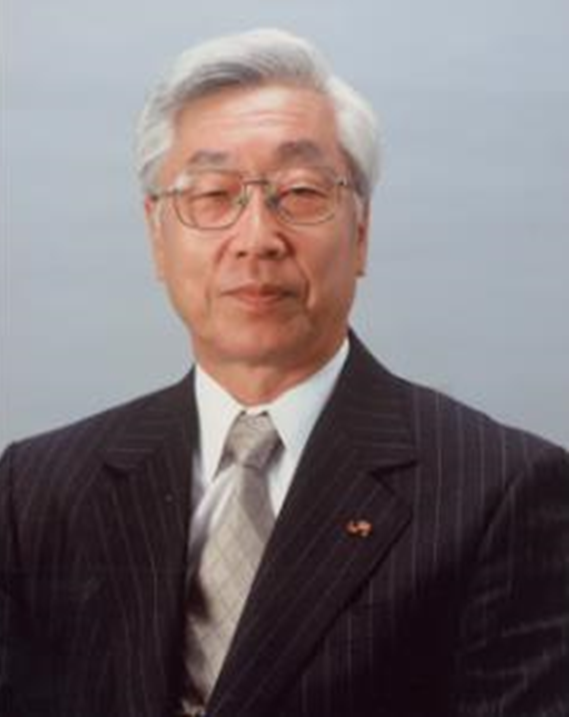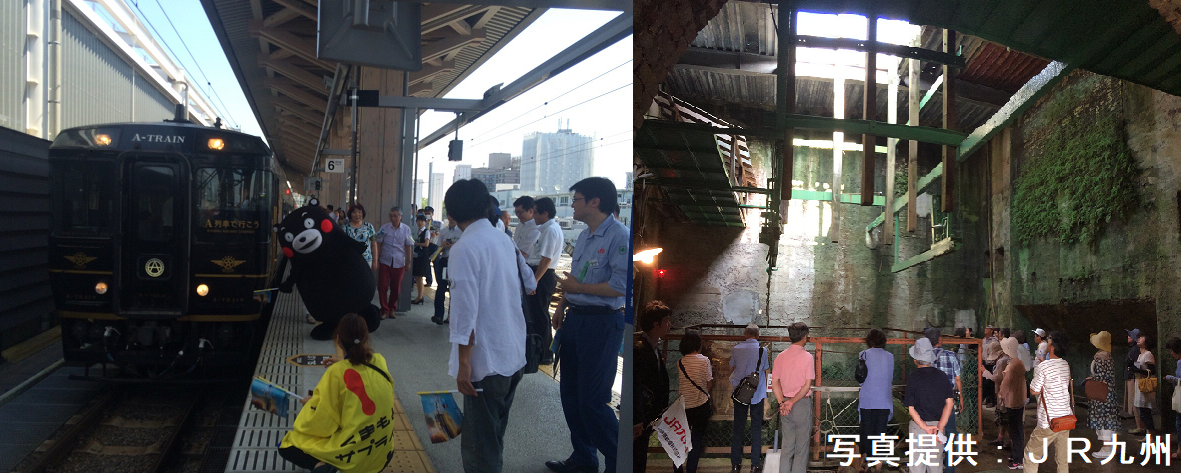PEOPLE
Chairman, Sites of Japan’s Meiji Industrial Revolution World Heritage Route Promotion Council Director, National Congress of Industrial Heritage

■Making the Rounds of the Kyushu Industrial Heritage Sites on the Seven Stars in Kyushu and the A-Train
ーーI have heard that JR Kyushu is already offering an industrial heritage tour route on the Seven Stars in Kyushu luxury train.
The route covers more than just the component sites, but, yes, a number of the component sites are included in optional tours on the train’s route. These include the Shoko Shuseikan in Kagoshima, Hashima Coal Mine (Gunkanjima) in Nagasaki, and Misumi West Port in Miike.
JR Kyushu also offers regular JR Kyushu Station Master Recommended Walking events. In the autumn of 2015, after the World Heritage listing of the Sites of Japan’s Meiji Industrial Revolution, eight walking courses covering the component sites were recommended and proved very popular. The company continues to offer walking events that include the industrial heritage component sites. In April, and again in June 2016, a one-night, two-day A-Train Tour of the Ariake Sea World Heritage Sites was offered in collaboration with Kumamoto Prefecture and prefectural tourism associations. These tours included explanations by local guides of Misumi West Port and Manda Coal Mine, and also the Amakusa Sakitsu hamlet which has applied to be listed as a World Heritage site.

ーーA large number of the components of the Sites of Japan’s Meiji Industrial Revolution are located in Kyushu. And needless to say, JR Kyushu is a major transport player in the region, particularly for the tourist industry. Please tell us your thoughts on the tourist industry in Kyushu and the expectations and issues that still need to be addressed.
As you know, I currently chair the Kyushu Tourism Promotion Organization. The Kyushu public and private sectors are working in tandem right now to develop tourism as a key industry for the region. The region’s total tourism revenue for 2017 is projected at roughly 2.7 trillion yen. Our goal is to push this up to 4 trillion yen in 2023. It’s an ambitious goal, but we are hopeful of an increase in visitors from overseas, the so-called inbound effect, and increases in travel expenditure rates. As it happens, automobile shipments from Kyushu currently total exactly 4 trillion yen. So, what we are trying to achieve is to make tourism a key industry on a par with the auto industry.
In 2017, last year, 28.69 million visitors came to Japan from overseas, the highest number ever. For Kyushu, the number was around 5 million for a growth rate of around 33% which is considerably higher than the average for all of Japan. Most of these people come from South Korea and other Asian countries, in part because there are a lot of direct flights from Asian countries to Kyushu’s Fukuoka Airport. Our next topic of focus will be how to get more tourists from Western countries to visit Kyushu.
ーーIt is true Fukuoka Airport is right in the city. There probably isn’t any airport more conveniently located in Japan.
Yes, local stakeholders have cited that convenience in their efforts to attract more direct flights from Asia, including those operated by LCCs. The inbound influx has changed our tourism industry considerably. Still, I think we need to attract more tourists from Western countries. Unfortunately, there are no direct flights from the United States or Europe in the winter. Fukuoka Airport has only one runway and little room for expansion. Still, we need to make greater efforts to promote the city of Fukuoka as one of Western Japan’s leading centers for tourism and business and increase its capacity to take in visitors. Localities throughout Kyushu need to take stock of their tourism resources and enhance their appeal as a travel destination. I am convinced there are still a lot of resources in Kyushu that we haven’t even tapped yet.
ーーHow do you position the Sites of Japan’s Meiji Industrial Revolution in the midst of all this and what are your future expectations for the role the Sites may play?
The Sites of Japan’s Meiji Industrial Revolution are scattered throughout Kyushu. The more of the heritage components tourists visit, the longer their stay in the region and the more they are likely to spend. This is what we are hoping for. And it means we need to provide explanations of the historical and cultural value of these sites for foreign visitors as well as those from other parts of Japan. We will need to learn more about their interests and needs.
Representative Director, National Congress of Industrial Heritage
(Honorary Advisor, Kyushu Railway Company (JR Kyushu)
Senior Researcher, Industrial Heritage Information Centre
Honorary Advisor, Nippon Mining Co., Ltd.
The Ambassador of Supporting Kamaishi Hometown
Former Director of Nagasaki City World Heritage Office
Former General Manager, Nagasaki Shipyard and Machinery Works, Mitsubishi Heavy Industries, Ltd.
Chairman, Fujisankei Group
Executive Managing Advisor, Fuji Television Network, Inc.
Executive Managing Advisor, Fuji Media Holdings, Inc.
Advisor, Federation of Japan Port and Airport Construction Association
(Ex. Chairman of Specialists Center of Port and Airport Engineering)
Mayor of Nagasaki City
Former Director of the Sano Tsunetami Memorial Museum (currently known as Sano Tsunetami and the Mietsu Naval Dock History Museum)
Director of NPO Association for Thinking about Satoyama
Director of National Congress of the Industrial Heritage
Honorary Chief Priest Toshinari Ueda
Former Mayor of Omuta City
Archaeologist and Heritage Conservation Specialist
A fellow of the Japan Federation of Engineering Societies
Team Member of the Industrial Project Team Office for the Promotion of World Heritage Listing under Cabinet Secretariat
Governor of Kagoshima Prefecture
Mayor of Hagi City
Mayor of Uki City, Kumamoto Prefecture
The Former Employee of Nippon Steel Corporation
An Associate Professor of the Faculty of Science and Engineering in Iwate University
Chairman of the Tourist Guide Association of Misumi West Port
President of Kuraya Narusawa Co., Ltd.
Chairman of Izunokuni City Tourism Association
Director and General Manager of Gunkanjima Concierge
Producer of the Gunkanjima Digital Museum
Owner at Tōge Chaya
Chairman: Mr. Hidenori Date
President: Mr. Masahiro Date
Proprietor, Houraikan Inn
Representative Director of Egawa Bunko non-profit incorporated foundation
The 42nd head of the Egawa Family
Democratic Party for the People (DPP) Representative for Nagasaki Prefecture
President of the NPO, Way to World Heritage Gunkanjima
Representative Director
MI Consulting Group
President of Watanabe Production Group and Honorary Chair of Watanabe Productions Co., Ltd.
Member of the House of Councillors
Governor
Kagoshima Prefecture
World Heritage Consultant
Director and Dean, The Kyushu-Asia Institute of Leadership
Representative Director, SUMIDA, Inc.
Journalist, founder of the Shimomura Mitsuko Ikikata Juku School
Representative, Rally Nippon
Chairman, Sites of Japan’s Meiji Industrial Revolution World Heritage Route Promotion Council Director, National Congress of Industrial Heritage
Representative Director, General Incorporated Foundation National Congress of Industrial Heritage (Advisor, Public Interest Incorporated Foundation Capital Markets Research Institute)
Mayor of Nagasaki City
Policy Director at Heritage Montreal
World Heritage Consultant
Executive Director of Kogakuin University
Heritage Architect and International Consultant
Head of Data Acquisition at The Glasgow School of Art’s School of Simulation and Visualisation
Head of Industrial Heritage, Historic Environment Scotland, Edinburgh
Scottish Ten Project Manager, Historic Environment Scotland, Edinburgh
Mayor of Izunokuni City, Shizuoka Prefecture
Pro-Provost and Chairman of Council of the Royal College of Art. Heritage advisor of Canal & River Trust for England and Wales.
Dean of Tokyo Rissho Junior College
Professor emeritus of Keio University
Mayor of Kitakyushu City
At the 39th session of the World Heritage Committee convened in Bonn, Germany, from June 28 to July 8, 2015, the decision was approved to inscribe the Sites of Japan’s Meiji Industrial Revolution on the World Heritage list.
At a celebratory party held to mark the occasion, some of the primary promoters of the project spoke of their joy in achieving their goal and of the trials and tribulations to getting there.
Director and Managing Executive Officer, Hanshin Expressway Company Limited
Member, Board of Directors, National Congress of Industrial Heritage
Vice-Governor of Shizuoka Prefecture
Mayor of Hagi City
Chairman, Tokyo Metro Co., Ltd.
Mayor of Omuta City
Deputy Director-General, Lifelong Learning Policy Bureau, MEXT
Former Counsellor, Cabinet Secretariat
Mayor of Kamaishi City
Member, Board of Directors, National Congress of Industrial Heritage Counselor, Shimadzu Limited
Chairman of the Consortium for the World Heritage Inscription of Modern Industrial Heritage (Kyushu-Yamaguchi) and governor of Kagoshima Prefecture (as of 2015)